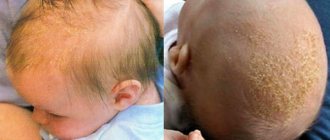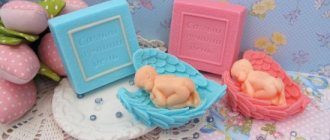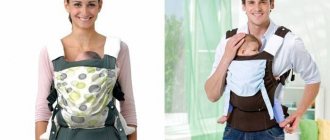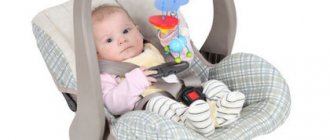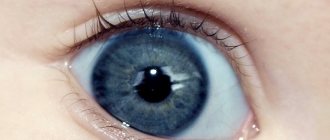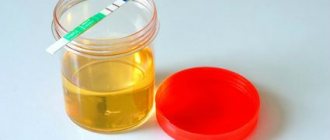Nail plates can grow into the surrounding fold not only in adults. Some parents are perplexed to discover that their newborn baby has an ingrown toenail. What to do? How to help the baby? Parents are wondering why this happened. After all, it is known that such a question is more relevant to people who wear inappropriate shoes, and in this case the baby has not even made an attempt to stand on his feet. However, this problem still occurs among children: it bothers the baby, causing him not only discomfort, but also real pain. That's why he cries, refuses to eat and sleeps poorly. It is important to identify the pathology in time, find out the causes of its occurrence and provide qualified assistance. It is worth considering that the disease can be acquired, which is explained by improper care of the baby’s nails, or congenital. In the latter case, pathological changes in the nail plate may occur in the womb, as a result of which the child is born with an ingrown nail (or more than one).
Reasons for the development of the disease
The reasons can be either external, depending on the parents’ poor hygiene of the child, or internal. As mentioned earlier, the disease can be congenital. In this case, heredity is usually blamed if in some family members the nail plate grows downward, damaging the skin. Typically, such an anomaly is characterized by symmetry, when the nail grows into the skin on both sides.
The problem may also be associated with the pathology of the baby's metabolic processes. In addition, a bacterial infection or a lack of vitamins can be a provoking factor.
Sometimes ingrown toenails in young children occur due to improperly selected shoes. It sounds strange, but some parents even put shoes on babies, which constrain the legs, squeeze the toes, and cause the nails to stick into the material of the elastic booties. In babies, the nail plate is very soft, it quickly gives in to any mechanical stress, so even too tight socks can deform it.
The disease is often caused by improper trimming of nails. When the procedure occurs too often, the nails may begin to grow ingrown. It is also not recommended to cut them too short. Sometimes parents are unable to trim their baby’s nails carefully due to his restlessness and restlessness. As a result, an uneven cut is formed, sharp tips lead to mechanical irritation, and subsequently to possible ingrowth of the plate into the skin. Therefore, a nail file in a children's manicure set is a must-have attribute. It is characterized by a soft abrasive, so its use can minimize trauma.
An ingrown toenail in a baby often occurs due to parents' attempts to give it a rounded shape. At the same time, they cut off the corners of the nails, while it is considered correct to leave a straight line.
How to cut a newborn's nails?
You can’t leave your child’s nails too long, because he can scratch himself, but how to cut them when his hands and feet are so small? Do it carefully. Also, your baby should wear scratch mittens that will protect him from scratches. However, from personal experience we know that a child can cope with scratches very quickly, so in the first month of life you can wear undershirts with closed arms. Experts recommend giving your baby his first “manicure” 2-3 weeks after birth. A newborn's nails grow very quickly; they need to be trimmed on the hands approximately every 2-4 days, and on the feet every 7-10 days.
Stages of pathology development
It is clear that the baby will not be able to tell where and how it hurts. He expresses his emotions by crying. Therefore, the only signal that a baby has an ingrown toenail can be his restlessness and twisting of his legs (handles). Therefore, if up to a certain point everything was in order, and then the child began to show anxiety, then it is worth carefully examining the baby’s body to detect a problem.
If an ingrown toenail in a baby was caused by hereditary causes, then the problem is discovered in the maternity hospital, when the doctor examines the baby. It is noteworthy that the pathology can be of varying degrees of complexity. Depending on this, the specialist prescribes specific treatment measures aimed at restoring the health of the plate. If the disease is ignored, it begins to progress. However, symptoms may appear in stages.
- Initially, a slight swelling of the lateral ridges appears. When pressing on them, the pain intensifies, which can be understood by the sharp cry of the child: when a doctor or parents try to examine a leg or arm, the baby instinctively pulls back the limb and cries.
- In the absence of therapeutic effects, the roller noticeably turns red. The tumor becomes pronounced, and pus may even appear. Again: if you try to put pressure on your finger, the baby starts crying a lot. It is worth considering that the child is constantly bothered by aching pain, so he is capricious and behaves restlessly even without touching the source of pain.
- At the last stage of development of the pathology, without medical intervention, severe inflammation of the soft tissues and their decomposition occurs.
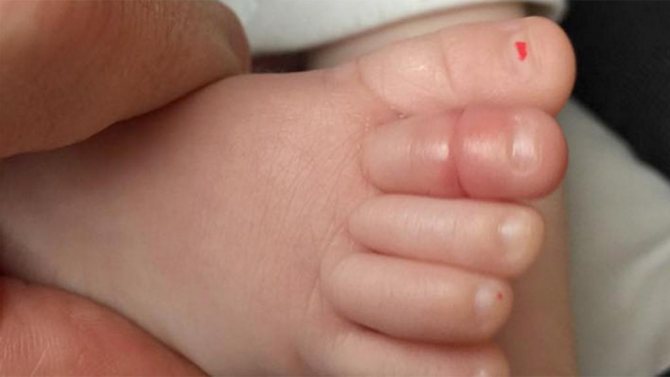
Symptoms and manifestations
It is easier for parents to detect an ingrown nail in a baby on their hands. On the lower extremities, the problem becomes obvious when the skin becomes inflamed. It is sometimes difficult for parents to understand what exactly is happening to their beloved child. The baby cannot say what hurts. He just cries and is capricious. But observant parents notice that anxiety increases when a sore finger is touched. Also, some children try to reach the problem area, remove the sock, or, conversely, try to move the foot away. If this behavior is observed, it is important to immediately inspect all fingers. If redness or swelling is detected, you should contact a specialist.
It is known that children's nails grow on their legs more often than on their arms. This is explained by the fact that sliders, socks, booties and even shoes are usually worn on the lower limbs. Therefore, it is difficult to notice the development of the problem in time.
Surgery
Treatment for an ingrown toenail in a newborn may require surgery. There may be several treatment options. The choice remains with the specialist and the baby’s parents.
The surgical method consists of performing a small operation using local anesthesia. The plate can be completely removed, or its shape can only be partially adjusted. Surgical manipulation consists of a traditional technique in which the doctor cuts the inflamed area of skin with a scalpel and removes part of the nail plate that is growing incorrectly. Next, a sterile bandage is applied to the resulting wound. It is important for parents to monitor the condition of the baby’s nails and their growth in the future.
As with any surgical process, this method has its pros and cons. The obvious advantage is that the problem is solved quickly and radically. The disadvantages include the need for anesthesia, the likelihood of psychological trauma in the baby and pain in the postoperative period.

The importance of nail hygiene
A large amount of dirt, which contains pathogenic microorganisms, accumulates under the nails.
The University of Pennsylvania conducted a study that involved 26 volunteers. When examining the hand, it turned out that there were as many microbes on the tip of one finger as on the entire palm.
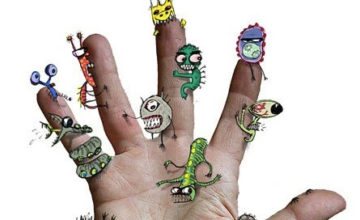
The experiment found that hand washing did not reduce the number of bacteria in this area, and artificial manicure increased the number of germs.
Therefore, cleaning this area is a mandatory hygiene measure.
Laser correction
Only a doctor can tell you how to treat an ingrown toenail in a baby. Here you cannot engage in amateur activities and diagnose pathology yourself. Modern treatment methods involve less traumatic operations, which undoubtedly reassures parents. Now doctors often use a laser instead of a scalpel, which makes intervention in a child’s body almost bloodless.
To begin with, a general examination and relevant tests are carried out, and only after that an operation is scheduled. To perform it, local anesthesia is used, and with the help of a powerful laser beam the problem area is removed. Next, a sterile bandage is applied.
The procedure has many positive aspects:
- 100% positive result is guaranteed;
- after surgery there are usually no relapses;
- the infant does not experience any discomfort during the operation;
- After the intervention, the child does not feel discomfort, as after surgery with a scalpel.
Why do black stripes appear on nails?
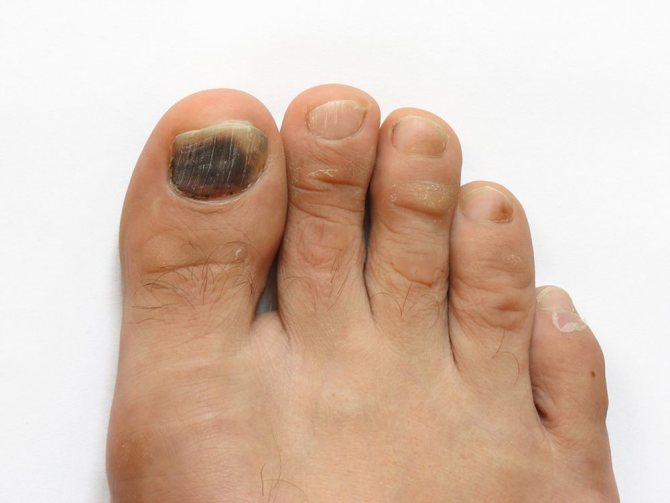
Spots, grooves and stripes on nails are a fairly common occurrence. Our body thus tries to pay attention to this or that metabolic disorder.
This mechanism is implemented very simply - the nail bed is penetrated by the finest capillaries, and all metabolic disorders affect it first. When the nutrition of the nail is disrupted, a white or black groove, stripe or spot is formed.
As a rule, in such cases, most women do not go to a dermatologist, but use all kinds of methods and manipulations in order to hide the defect that has appeared. This makes it difficult to diagnose and timely treat a particular pathology.
How you can help at home
Of course, few parents want to subject their baby to surgery, but if the baby has an ingrown fingernail or toenail and is at an advanced stage, then surgery remains the only possible way to relieve the pathology. If the problem has just arisen and the parents have identified it in a timely manner, then it seems possible to get rid of it using improvised means, but without fail with prior consultation with a doctor. To do this, you need to steam the damaged area and cut off the sharp end of the nail with small nail scissors. The affected area is then treated with alcohol. Herbal and other baths are recommended for steaming.
Basic ways to remove dirt under nails
Simple and affordable cleaning methods are carried out using tools and folk recipes are used.
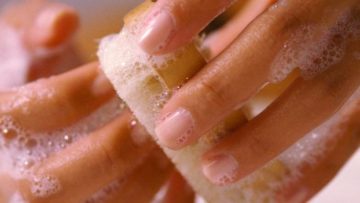
- The brush is used after washing your hands or taking a bath: the nail plate is treated from the outside and inside (a toothbrush will also do).
- Scissors. You can remove dirt with a sharp tip. To do this, you should choose a well-lit place so as not to injure the skin. Cleaning is carried out on dry hands.
- A scraper is a double-sided metal tool. On one side there is a spatula, on the other there is a hatchet or spear. The instruments are not sharp, so injury is excluded. The scraper is easy to disinfect.
- The cuticle pusher (pusher) has a rounded shape with straight edges.
- A curette is a device for cleaning the subungual space; it has pointed edges of different shapes on the sides.
- Use a toothpick in the same way as an orange stick, but be careful not to damage the skin.
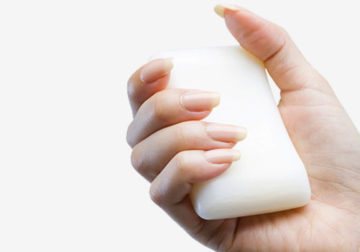
- A simple cleaning procedure is carried out by rinsing your hands with light natural soap. The detergent should be mild. It is better to purchase a special OrigiNails Bubble White powder, which guarantees cleanliness in 5 minutes.
- Means for treating dentures. It contains citric acid and sodium bicarbonate. To clean, brushes are immersed in the composition to better remove debris.
- Handwash. It’s easy to get rid of stubborn stains under your nails if you wash things by hand. To do this, use soft detergents, for example, washing powder. After work, hands are lubricated with a nourishing moisturizer.
- When washing your hair, due to the foam from the shampoo, everything is washed out on its own.
Solution for steaming a finger with a damaged nail
To make the steaming procedure more comfortable and effective for your baby, you can use auxiliary products in the form of herbal decoctions. The herbs themselves can be picked and used fresh, or you can buy dried herbs at the pharmacy. To prepare the decoction, add 6 tbsp. l. herbs chamomile, calendula, mint, burdock or nettle with two liters of boiling water. The resulting drug should be placed in a dark place and allowed to cool for 40-60 minutes. After this, they filter it, check the temperature with their own hand and allow the baby to dip the hand or foot with the problem nail into the container. During the procedure, it is necessary to distract the child and talk to him gently so that the steaming time is at least 10 minutes.
Next, the limb is removed, wiped dry and the painful area of the nail that is bothering the child is cut off. After this, it is important to place a cotton wool soaked in brilliant green or iodine on the treatment site to prevent infection. At the end of the manipulations with steaming and cutting the nail, clean socks are put on the legs, and special “scratchers” are put on the arms.
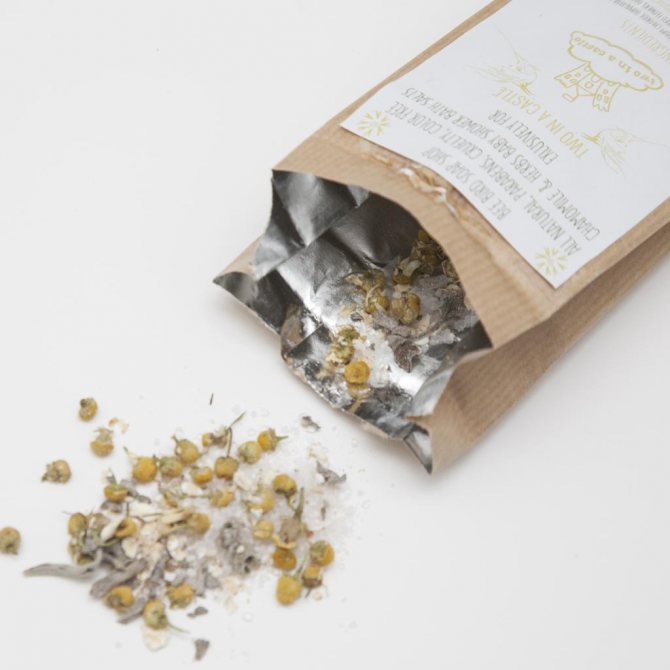
Salt compresses
For any conscious parent, it is extremely unpleasant to discover a source of pain in a child. But if the baby still has an ingrown nail, what should you do? As an alternative to taking medications before visiting the pediatrician, salt compresses are recommended. For example, if the problem is discovered in the evening, the inpatient doctor’s appointment time is over, and self-diagnosis and self-treatment by parents are unacceptable, it makes sense to use a salt compress. It has the effect of relieving unpleasant pain and has a beneficial effect on the skin, softening it and minimizing swelling. To prepare the solution, you need to stir 1 tbsp in a glass of hot water. l. table salt. Next, you need to wait until the water reaches a comfortable temperature for the child, and then dip the child’s hand or foot. It is noteworthy that even pus can be removed from the wound using this method, since it allows the resulting pustules to open.
Deep cleaning
Heavy stains can be easily and quickly removed using simple methods.
Citrus fruits help clean your nails. Any sour fruit, such as lemon, will do:
- Squeeze juice from 1 fruit.
- Apply to desired area.
- After 10-15 minutes, wash your hands.
If the frozen stain is located deep under the nail, then you need to cut the lemon in half and immerse your fingertips in the pulp (hold for no more than 15 minutes).
After the acid, be sure to apply cream or vitamin E with vegetable oil to the skin of your hands.
This is a wooden product in which one end is pointed and the other is cut at an angle. A stick is convenient for scraping out particles in narrow places.
The material has disinfecting properties, and cleansing occurs more delicately than with a metal object.
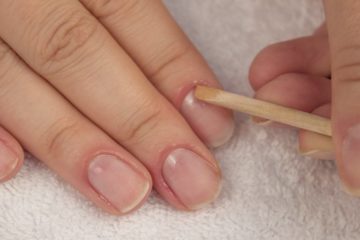
- Insert the tool into the free space under the nail (it is important not to move the skin).
- Draw the tip from one edge to the other.
- Remove dirt.
- If necessary, repeat the procedure.
Traditional medicine recipes
Traditional medicine often surprises with its healing recipes. In the case of purulent abscesses in the area of an ingrown toenail, she also has her own specific recipes aimed at relieving inflammation and bringing skin tissue back to normal. One of them is the so-called garlic-onion therapy. To prepare the product you need the following ingredients:
- one onion;
- garlic clove;
- one aloe leaf;
- melted butter (butter is fine) – 1 tsp;
- beeswax – 1 tsp.
Chop the onion, garlic and aloe leaves, add oil, wax and place on the stove, where you need to boil the mixture for about five minutes. To prevent the paste from burning, it must be stirred regularly, preferably with a wooden spoon. Then the container is removed from the stove and the contents are cooled. The resulting mixture should have a thick consistency, which should be rubbed into the skin around the baby’s nail on the arm or leg. You need to spread it very thickly, cover it with a cabbage leaf on top and bandage it. If the problem is on the foot, then wool socks are preferable. You can get by with “scratches” on your hands. If the procedure is carried out for several days in a row, the problem of inflammation and ingrown nails usually goes away.
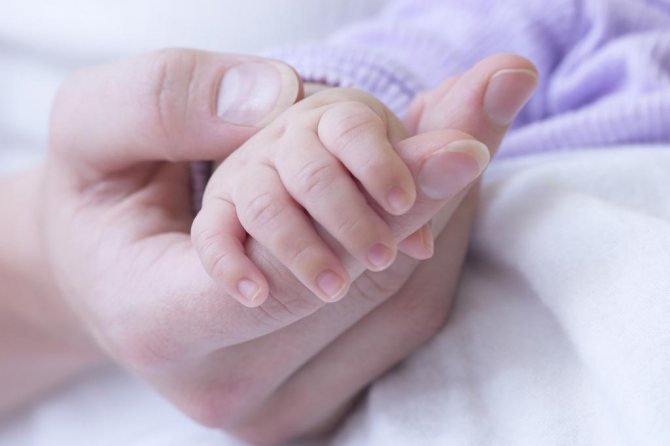
However, it must be taken into account that the use of traditional medicine methods must necessarily be agreed upon with a pediatrician or pediatrician. Self-medication in this case is unacceptable.
Preventive measures
If an ingrown nail is discovered on a baby’s hand, and the problem is acquired, then the parents are almost always to blame for the situation. Therefore, in order to save the baby from suffering and prevent the need for surgical intervention, pediatricians advise following simple rules for caring for the child:
- carefully trim the baby’s nails, but do this no more than once a week;
- for the little ones, use special children’s clippers rather than nail scissors;
- try not to round the shape of the nail and cut it in a straight line;
- Make sure there are no sharp edges that could injure the skin.
If you follow these precautions, the risk of finding an ingrown toenail in your baby is minimized.

What to do to prevent your nails from getting dirty
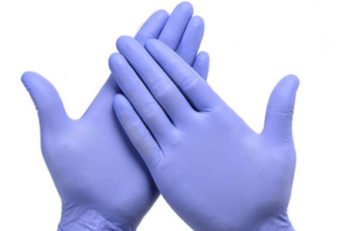
- Gloves. Latex products are suitable for working in the garden.
- An old proven method is soap. Scrape along it until the space under your nails is completely filled. If the surface is hard, moisten with water. A protective crust is formed, which is then easily washed off.
- Special liquid gloves protect against contamination. The product is applied generously and left until completely dry. A protective film is formed on the skin, preventing particles from entering. By analogy, liquid soap is used instead of expensive store-bought gloves.
- To prevent dirt from getting in, apply silicone cream to your hands before work.
Timely detection of the disease and the possibility of relapses
Thus, ingrown nails in a baby can be either a consequence of a congenital anomaly or the result of improper hygiene and care of the nail plate by the baby’s parents. If the nail is just beginning the process of growing into the skin of the cushion around the plate, then you can try to cope with this problem yourself, at home, using improvised means and appropriate steaming with compresses. But if the problem has reached serious proportions and the inflammation has become critical, the baby urgently needs to be shown to a specialist.
Practicing surgeons advise that in case of severe swelling and severe inflammation, do not delay the operation. Otherwise, you will have to remove the entire plate. As a result, such a nail may not grow back at all, and the process of restoring the baby’s general condition will be long and painful.
Sometimes the problem recurs. If after successful treatment a relapse occurs, then corrective manipulations are necessary, in which the doctor changes the shape of the nail itself. However, it is important to prevent such a situation, because any intervention at such a young age threatens many side effects.
Causes of Streaks and Spots on Nails
The sooner the cause of a particular process is determined, the better for health.
Streaks on nails may be the result of an incorrect diet
For example, one of the most popular causes of stripes is a deficiency of microelements and vitamins in people on strict diets. In this case, the onychologist recommends vitamins, good nutrition and consultation with a nutritionist.
Amateur diets are a profanation of the very principle of diet therapy, leading to numerous metabolic disorders. The diet should take into account the individual characteristics of the body, including the rate of elimination of certain substances by the kidneys and liver, the patient’s age, concomitant pathologies and much more. Take your time - visit a nutritionist to create an adequate menu.
After the deficiency of iron, zinc and vitamins is restored, after some time the characteristic stripes and spots disappear.
Quite often the situation is associated with visits to beauty salons, i.e. with a traumatic moment. The black stripes in this case are longitudinal.
Black stripes may be associated with mechanical damage to the finger, such as a bruise
A bruised finger may also be accompanied by the appearance of black stripes, but in this case the diagnosis lies on the surface - damaged and swollen soft tissues themselves indicate the cause of this situation. With constant trauma (some working specialties), the number of such strips increases, and onychodystrophy develops.
Black longitudinal stripes often occur in older people. This is due to atherosclerosis of small vessels at the base of the nail. The nail plate itself becomes deformed due to nutritional deficiency - thickens and splits.
The condition of the nails may reflect problems with blood vessels
Sometimes dark stripes appear on the big toe nail due to gout, in other cases they accompany arthritis and psoriasis. The color of the stripes in this case can vary, what is more important is their very presence. In case of cardiovascular diseases, the stripes on the nails are mainly located in pairs along the edge of the nail plate.
If a bumpy surface of the nail is added to the dark stripes, this may indicate arthritis or arthrosis.
Processes that cause predominantly black stripes on nails:
